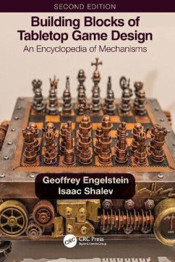Building Blocks of Tabletop Game Design: An Encyclopedia of Mechanisms

This book was written by two board game experts, one of which is a professor at the NYU Game Center, which I didn’t even know was a thing.
The book breaks down games into patterns – the “building blocks” of the title. It groups them into categories:
- Game Structure
- Turn Order and Structure
- Actions
- Resolution
- Game End and Victory
- Uncertainty
- Economics
- Auctions
- Worker Placement
- Movement
- Area Control
- Set Collection
- Card Mechanisms
Each category has between eight and 26 variations. Each one is named, numbered, and discussed. (Also, each one has a unique chapter header graphic, which uncannily visually represents what’s being discussed – they were very entertaining, and I tip my hat to the illustrator who had to think them all up.)
There’s lot here. For example, the authors describe 18 different types of auctions, which I didn’t even think was possible: there are Open Auctions, English Auctions, Sealed-Bid Auctions, Selection Order Auctions, etc.
It’s tilted towards the newer crop of in-depth board games, but some mechanisms are related to classic card games and occasionally even simpler board games like Candyland and Monopoly.
I have no intention to ever design a board game (although I did this all the time as a kid), but I love the idea of putting rules and structures around domains of imagination. I enjoyed the breaking down of games into patterns, and it gave me some appreciation that games are really just varied constructs of known devices.
In the introduction, the authors talk about a class exercise where students are given random patterns and told to design a game using them. When I read this at the beginning, I thought the idea was madness. But by the end, I couldn’t totally envision myself doing it.
In the end, though, who is this book for? I suspect it might be a textbook (it was certainly priced like one – I paid $110 for it, on sale). Other than actual students of game design, the audience is limited. I like it, but I’m weird like that, and I don’t know how many more of me there are out there.
Book Info
- I have read this book. According to my records, I completed it on .
- A hardcover copy of this book is currently in my home library.